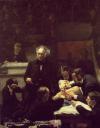One of the three reasons for starting this blog, is medical history. So, let’s have a little history.
I am giving a lecture the Monday after Thanksgiving about the medical history of the Civil War. This is an interesting period because anesthesia had been in use for 14 years when the war began but the concept of antisepsis would only appear two years after its end. At the beginning of the war, the US Army was tiny and scattered and the medical corps was in the hands of incompetents. For example, they had provided no textbooks to save funds. As the war began, Samuel Gross, a professor of surgery in Philadelphia, wrote his own textbook of military medicine in nine days. It was copied by the Confederates in 1863 and became their medical “bible” as well.
This painting of Gross in his surgery clinic is one of the most famous of American medical paintings. The procedure was one of draining an infected femur. Surgery in America, or anywhere ese, in 1860 was very basic and few sophisticated procedures were even contemplated. You might also note the absence of any attempt at antiseptic practice. There are no gowns or gloves and the thought that contamination of the wound was a hazard was unknown.
The textbook was very basic, chiefly concerned with how to do amputations. In 1860, a compound fracture, that is a fracture in which the bone ends are exposed to the outside either because they have penetrated the flesh, or because a bullet or other missile caused the fracture, was fatal without amputation. There was no understanding of infection. Even in 1867, when Lister published his famous first report of anti-sepsis, he did not know why infection occurred. It would be 20 years before infection was known to be due to microscopic organisms called bacteria.
Tags: History



Good stuff, Dr. K.
It seems germ theory, and cleanliness of surgical procedures, was slow to be accepted, by the old dogs in the medical community, and the population at large. I find this interesting, because soap and hot water were standard for cleaning kitchen utensils prior to 1867. One would think someone would have thought to apply this to surgical instruments.
All so fascinating. The lack of understanding of the source and cause of infection is horrific. I’m always grateful to live in a era where we’ve learned that the simple expedient of washing hands thoroughly is a life saver.
Florence Nightingale applied soap and water to the wounded and sick of the Crimean War and reduced the death rate in Scutari Barracks hospital from 40% to 2% but she didn’t know why it worked. The British casualties were KIA: 2,755
Died of wounds: 2,019, Died of disease: 16,323, Total: 21,097. This was the usual proportion until the First World War, which was the first war in history in which more soldiers died of wounds than of disease. In the Civil War, 27,000 soldiers died of diarrhea. That was only the Unon side. Most Confederate records were lost when Richmond burned. A Confederate medical officer wrote that no soldier in his army had a formed stool during the war. Nasty little side of war that is not well known.
Based on the informative post above, I do hope you will be posting your lecture after you’ve given it.